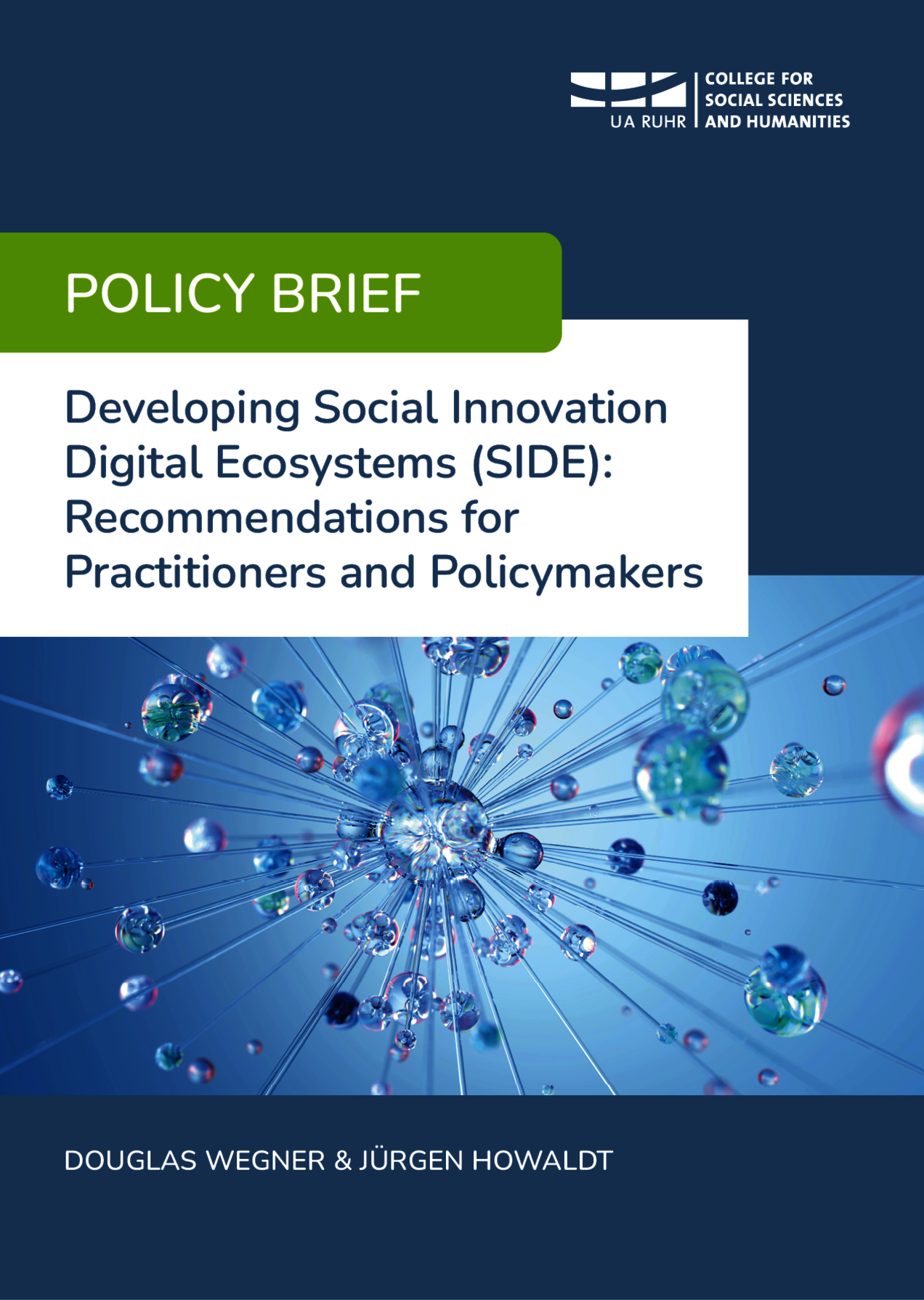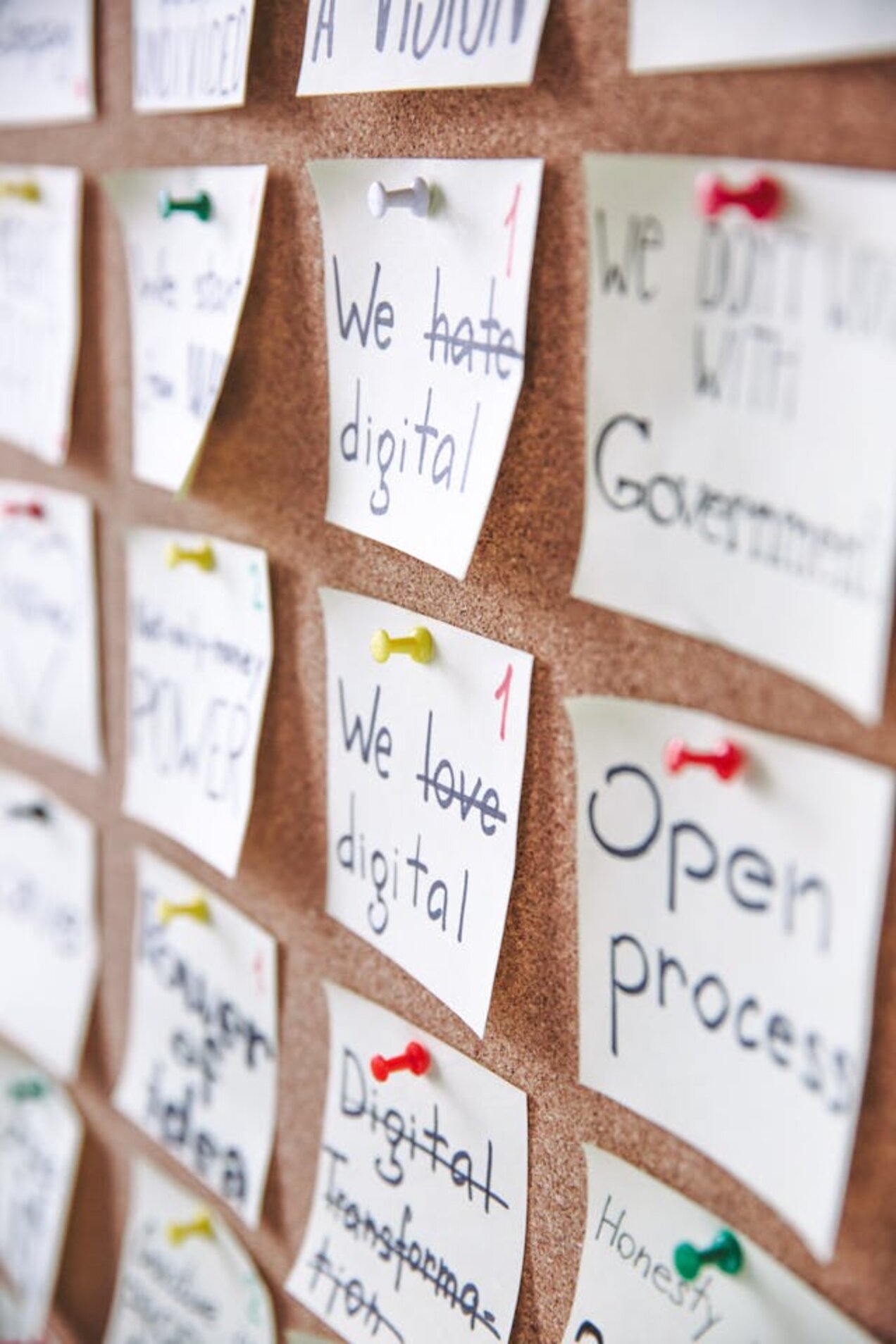
The policy brief is available as PDF on Zenodo.org:
View as PDF

This policy brief results from a research project on Social Innovation Digital Ecosystems (SIDE) developed at the College for Social Sciences and Humanities at the University Alliance Ruhr (UA Ruhr) from March to August 2024. The project aimed to unveil the potential of Social Innovation Digital Ecosystems (SIDE) in the digital era. A SIDE is not just a platform but a dynamic community of actors united by a common goal to develop social innovations that address society’s challenges through a collaborative, inclusive, and open process.
Our recommendations result from sixteen interviews with researchers and social innovators, a workshop with participants from Europe and Latin America, and discussions with researchers at scientific conferences. Social innovation digital ecosystems are still an emerging phenomenon, but experts and practitioners agree that SIDE can help develop and escalate social innovations. Their development can support and ease the work of citizens, civil society organizations, universities, and private companies engaged in social innovation initiatives.
We hope you enjoy reading our brief!
Douglas Wegner & Jürgen Howaldt
Our society’s most pressing challenges in the 21st century cannot be solved by the traditional top-down approaches we used in the last decades. Now, we see that most of the approaches we used in the past did not work. In some cases, they contributed to creating new issues we must now deal with. Problems such as climate change, poverty, pollution, starvation, forced migration, and labor market changes have complex causes and effects that governments and society cannot solve with simple solutions. Indeed, solving these thorny problems requires strong collaboration among several partners, even those with different perspectives on how to act.
There is also a growing comprehension that technological innovation may not be enough to solve all societal problems. Although new technologies help us address some problems, they can also contribute to creating new challenges, as becomes clear when considering the controversial effects of social media and artificial intelligence. Therefore, technological innovations must be accompanied by social innovation, i.e., new social practices co-developed by communities and stakeholders to address their problems. In short, rather than top-down solutions proposed by single actors or authorities, this bottom-up approach zooms in on the collaboration and mobilization of those affected by the problems.
Fortunately, governments and policymakers increasingly comprehend that technological and social innovation must be considered at the same conceptual level. While fostering technological innovation remains important, some governments have already recognized that social innovation must also be supported to produce social change. This can be done via advancing specific initiatives but may have greater effects by promoting social innovation ecosystems that unite all the actors, public agencies, universities, research institutions, and companies that want to make social innovation flourish.
 ©
Unsplash / Dylan Gillis
©
Unsplash / Dylan Gillis
Social innovations are frequently the result of extensive collaboration among stakeholders from different sectors. People involved in social innovation initiatives often rely on the support of agencies, universities, civil society organizations, and even private companies that offer resources, knowledge, and networking opportunities to make these social innovations thrive. These actors form a social innovation ecosystem that promotes collaboration and helps social innovations emerge, develop, and institutionalize. The extent to which actors and supporting organizations in a city or region know each other and interact to produce joint outcomes determines the strength of the local social innovation ecosystem.
Recently, digital platforms have also been used to expand social innovation ecosystems and stimulate connections between stakeholders. A great example comes from the city of Florianópolis in Brazil. There, a team of researchers created a platform that maps all relevant actors involved in social innovation initiatives (see Case Study I). Another example is the German Platform for Social Innovation and Social Enterprises, which aims to constitute a nationwide digital ecosystem offering information and stimulating connections among social innovators and entrepreneurs (see Case Study II). Both cases are examples of digital ecosystems whose main aim is to help social innovation flourish and produce a broader impact on society.
The Social Innovation Observatory of Florianópolis aims to map and connect people, organizations, and social innovation projects in Florianópolis, a city in southern Brazil with 500,000 residents. The creation of this digital platform is based on four main ideas (Andion et al., 2022). First, it views the social innovation ecosystem as a network of various sectors (governments, businesses, academia, and civil society) operating at different levels (macro, meso, and micro) within public spaces. Second, the platform includes geographical analysis to track social innovation projects over time. Third, it encourages public discussion by creating spaces where participants can share their practices through collaborative learning. Fourth, beyond mapping people, organizations, and projects, the platform aims to provide a detailed and long-term view of the social innovation ecosystem, showing forms of cooperation and interaction and the impact of these practices in the public sphere (Andion et al., 2019).
The platform allows for observing the development of the social innovation ecosystem at the intersection of existing institutions and the creative efforts of different participants. It also promotes collaborative learning by enhancing offline spaces for discussion, public awareness, exploration, and collective experimentation to address public issues.
OBISF aims to strengthen and spread public inquiry practices in the city, contributing to more sustainable development. As of February 2024, the platform recorded 543 supporters of social innovation and 734 projects addressing social problems. Of these, 236 were directly observed and analyzed by the research team, while the remaining 498 were mapped using publicly available secondary data. Several new initiatives have been started over the last few years by connecting organizations and entities mapped by the digital platform, creating a new stimulus for social innovation in the city.
Sources:
Andion, C., Alperstedt, G. D., Graeff, J. F., & Ronconi, L. (2022). Social innovation ecosystems and sustainability in cities: a study in Florianópolis, Brazil. Environment, Development and Sustainability, 24(1), 1259-1281.
Andion, C., Alperstedt, G. D., & Graeff, J. F. (2019). Social innovation ecosystems and cities: Co-construction of a collaborative platform. In J. Howaldt, C. Kaletka, A. Schröeder, & M. Zirngiebl (Eds.), Atlas of social innovation. (2nd Volume: A world of new practices). Dortmund: TU Dortmund University, European School of Social Innovation.
ObservaFloripa (2024). [Institutional website] Observatório de Inovação Social de Florianópolis. https://www.observafloripa.com.br. Access: April 20th 2024.
This platform is an initiative led by Dortmund University, the Social Entrepreneurship Netzwerk Deutschland e.V., and Social Impact GmbH. Its main goal is to be a “one-stop shop” for social innovators and entrepreneurs, offering tips, funding and networking opportunities. The platform also aims to connect research and practice in the field of social innovation. Funding from the Federal Ministry of Education and Research and the Federal Ministry of Economy and Climate Protection indicates that the platform aims to be an important digital space for social innovation and social entrepreneurship in Germany. It comprises three main sections: impact tools, funding, financing and consultancy finder, and events.
The first section offers impact tools for methods, management, and measurement that support social innovators and entrepreneurs. This section connects theory and practice since the available tools have been developed by researchers and are theoretically supported.
The second section presents over 140 funding, financing, and supporting organizations. It aims to ease the process of finding funding or financing opportunities and connects entrepreneurs and social innovators to organizations that can effectively support the initiatives.
The platform’s third section aims to publicize the online and onsite conferences, events, and workshops in the field of social innovation and entrepreneurship that are taking place in Germany.
Finally, the platform serves as a learning hub where people can find courses and training about the abovementioned topics. Due to the multiple actors and subjects involved in the platform, it constitutes an emerging digital ecosystem for supporting social innovation in Germany.
Sources
Plattform für Soziale Innovationen und Gemeinwohlorientierte Unternehmen (2024). Available at https://sozialeinnovationen.net. Accessed 02 July 2024.
 ©
Pexels / Polina Zimmerman
©
Pexels / Polina Zimmerman
Positive social change requires that social innovation walks hand-in-hand with technological innovation. They are not antagonistic but complementary. This means that governments need to recognize the role of social innovation and support it through specific policies, structures, and practices. Local and regional social innovation ecosystems can be strengthened by articulating a set of actors to foster both types of innovation.
Governments and universities can stimulate the cross-pollination of ideas and knowledge by creating spaces where these two communities can meet and interact. Social innovation initiatives may benefit from technological entrepreneurs, while the latter may be influenced by projects and initiatives focused on social transformation. Events, workshops and calls for funding should engage people from both communities and stimulate their collaboration to produce a wider social impact.
While bottom-up initiatives to develop digital ecosystems such as The Social Innovation Observatory of Florianópolis are admirable and welcome, governments and policymakers should also actively participate in creating SIDEs. They usually have the financial resources and the legitimacy to start new projects like digital ecosystems but need to partner with other organizations to spread the initiatives and make them work.
Initiatives to create Social Innovation Digital Ecosystems have a greater chance of thriving when public authorities truly believe in their potential impact and support them. Governments and policymakers must be open to including social innovation in their political programs and sponsoring digital ecosystems. Therefore, taking part in the political conversation and advocating for SIDE development is an important strategy for practitioners and researchers who want to create and develop new ecosystems.
Social innovation is strongly contextual and, in most cases, community-specific. This means that each solution is connected to the reality of a distinct community or group of people. It might result from a test-and-error process in digital and physical environments. SIDEs can support the actors in several ways by offering knowledge, resources, and connections, but they may not completely replace physical onsite interaction. Initiatives that combine digital and onsite activities have higher chances to succeed.
Social innovation digital ecosystems can operate at different levels. For instance, they can connect people to discuss common problems and co-develop solutions. However, they can also operate at an institutional level, providing information to organizations, initiatives, and public actors about social innovation. The first alternative may get better results by using technologies that people already know and use, while the second alternative may require a new platform and strong incentives to make organizations use it consistently.
Social innovation results from a collaborative process in which people and organizations engage extensively. Therefore, digital ecosystems can only work and achieve effective results if they attract, mobilize, and retain citizens, community leaders, and organization representatives throughout the process of collaboration and co-design. Social innovation requires specific strategies and policies to train people to use digital technologies, especially in developing countries. SIDEs must be inclusive and easy to use.
 ©
Pexels / Brooke Laven
©
Pexels / Brooke Laven
Digital ecosystems may have a relevant role in fostering social innovation. They can help connect the actors—citizens, community leaders, non-governmental organizations, support and funding organizations, and public agencies—that produce and spread social innovations. Emerging cases such as The Social Innovation Observatory of Florianópolis and the German Platform for Social Innovation and Social Businesses reveal how digital ecosystems foster new connections, spread knowledge and practical information, and help social initiatives find the support they need at different stages. However, SIDEs also must overcome several challenges to produce the expected effects. In summary, this policy brief offers recommendations for governments and practitioners who want to stimulate the creation of social innovation digital ecosystems or strengthen existing ones. There is still a long way to go regarding SIDE creation and adoption by social actors, but the existing examples show a promising future.
We would like to thank Carolina Andion (Udesc – Brazil), Laura Temmerman (Vrije Universiteit Brussel – Belgium), Christoph Kaletka (TU Dortmund – Germany), the experts and practitioners we interviewed, the workshop participants at the College, and the discussants in EU-Spri conference, for their valuable contribution to this project. The recommendations presented in this policy brief have emerged due to their comments and insights.